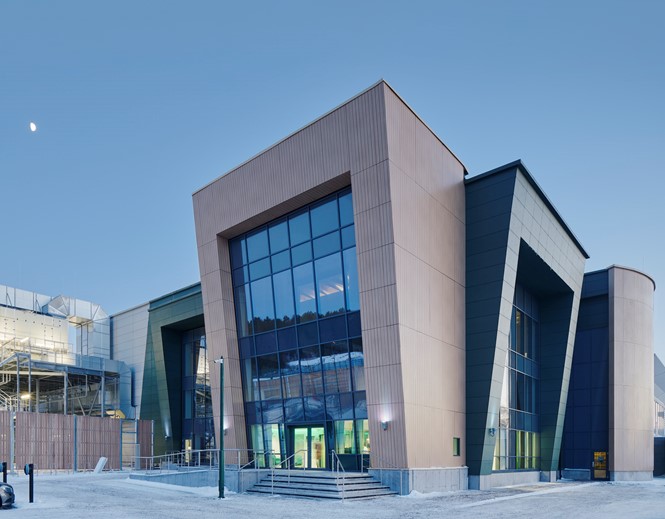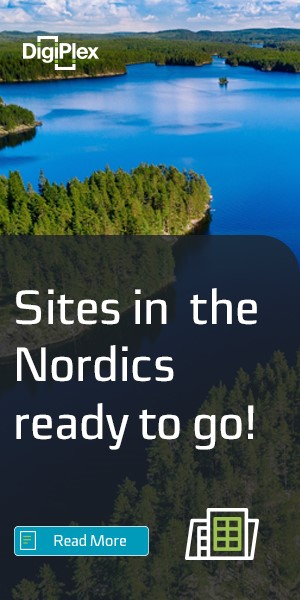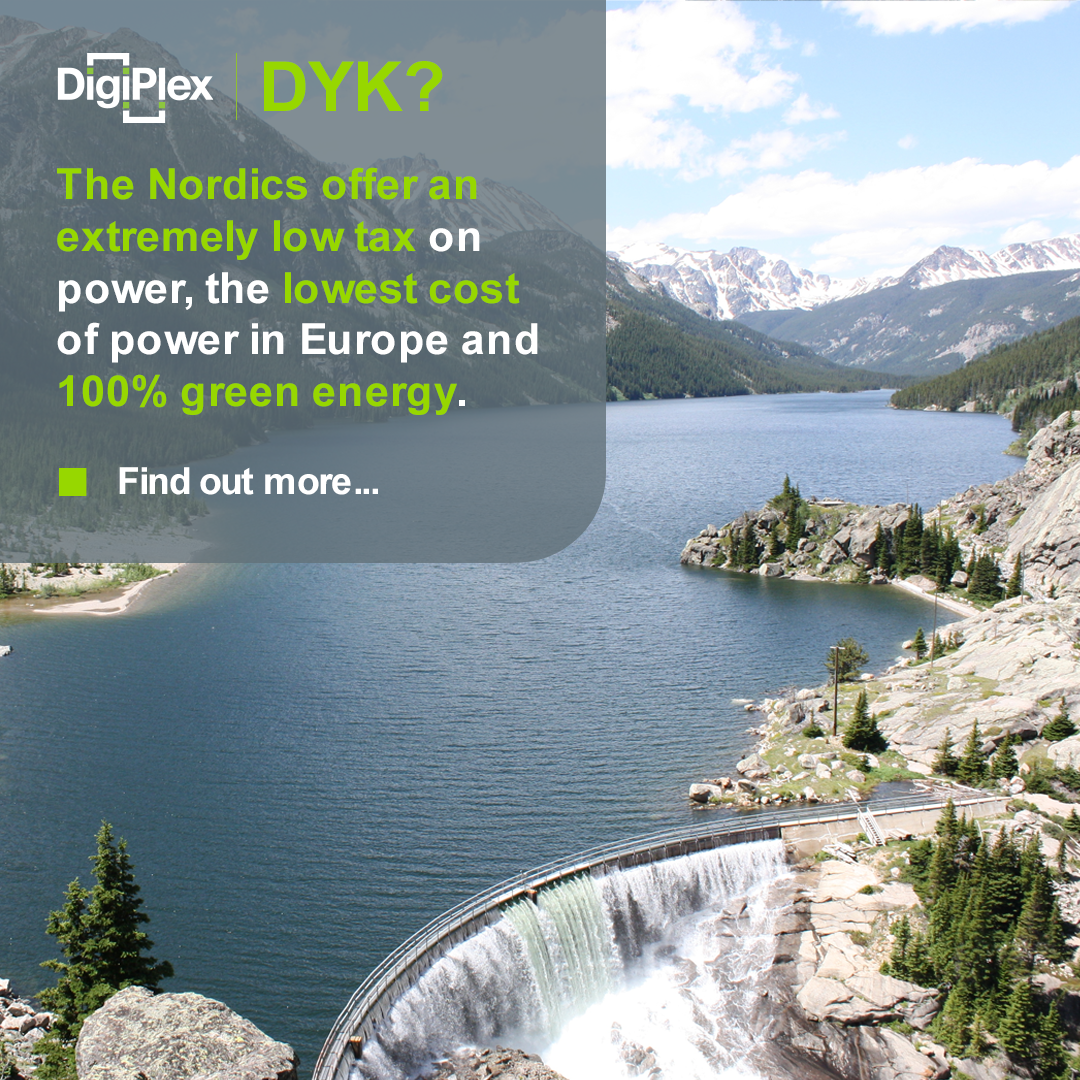Leading lights

The northern lights provided the inspiration for its visual brand, but data centre provider DigiPlex has been leading the way in sustainability throughout its history. Brittany Golob reports on the company’s brand and communications transformation.
The aurora borealis, or northern lights, occurs when charged electrons bombard the Earth’s magnetosphere at the high latitudes, resulting in heated energy that humans perceive as moving lights. The internet is visible to most people only as images on a screen. But behind that, its complex infrastructure is powered by the electronic signals that send packets of information around the world.
Its an apt metaphor, then, for a data centre brand to adopt the northern lights as part of its visual identity. Even more fitting for one that has a strong Nordic heritage. For DigiPlex, the visual expression of its heritage and positioning was but one part of a rebrand that sought to achieve no less than transforming the data centre industry itself.
“There are two things shaping the way we live today. One is digitisation. Everything that can be digitised will be digitised,” says DigiPlex’s chief commercial officer, Frederik Jansson. “The second one is climate change becoming climate action. We need to change the way we live, act and behave to ensure we have a world left for our kids. Those two huge mega-trends converge inside a data centre.” DigiPlex is the data centre most poised to represent that convergence, considering its sites across the Nordics and its existing green energy model. The company has used hydroelectric power to fuel its data centres since 2000.
Cooling is one of the primary modes of energy consumption at data centres. Servers generate a lot of heat; cooling them takes a lot of power. “Data centres have been IT’s dirty little secret,” says Jansson. But DigiPlex also capitalises on the climate itself, relying on the frigid air in the Nordics to cool its centres. And, by 2022, the company aims to reuse enough of the waste heat generated by its data centres to power 15,000 homes, building circularity into the business model.
The commitment to sustainability has been in DigiPlex’s DNA but that wasn’t the case for others in the industry. DigiPlex had to express its points of difference to its audience and generate interest in a sustainable data centre. In fact, in a survey of Nordic businesses conducted by DigiPlex, sustainability was 27 out of 27 criteria regarding data centre selection. “We had to do a number of things,” Jansson says, “One was to find a way in which we could tell this story in a non-technical way so people could actually understand it.”
DigiPlex embarked on a transformational change programme that addressed not only the company’s brand, but how it communicated about itself and how it communicated about its industry.
“The funny thing is in today’s world, up until recently, this hadn’t been discussed. It had been nowhere in the media debate,” Jansson says. “Every time you browse the internet, stream a television series, use social media or log in to your internet bank, a process starts in a data centre. If that data centre is a power hungry, coal fired one you are contributing to climate change – most likely unknowingly.” Bucking the trend, DigiPlex decided to talk about this. It wanted to make sustainability a purchase consideration for business decision makers and an important consideration for internet users. But, DigiPlex’s 20 plus year legacy made it harder to approach change. “We had to find a USP that fit with our legacy. Lucky for us, DigiPlex has been on the forefront of sustainable data centres for our entire existence,” adds Jansson.
The first step was explaining it in a straightforward way. And DigiPlex turned to the Wall Street Journal to do so. Jansson shared the concept of circularity and his team created a 45 second video explaining it further.
That was just the first step in the SEO-driven brand positioning transformation. To become ‘the voice of sustainable data centres,’ DigiPlex had to rethink its communications strategy and focus on the c-suite. It then had to deliver thought leadership content focused on sustainability and data infrastructure. Finally, it worked with influencers to amplify its content and improve its SEO. This resulted in its awareness levels increasing from 12% to 56% while also propelling sustainability into a top consideration for data centre decision makers. When DigiPlex examined the market again 2 years later, it found that sustainability had jumped from the 25th most important consideration to the fourth, proof positive of its strategy’s efficacy.
DigiPlex also examined consumer preference regarding internet sustainability. Most consumers said they wanted internet companies and digital services to be more sustainable, but only a minority was willing to limit their time online to achieve that. The decision to act more responsibly has to sit within the supply chain. Jansson says, “We looked at it very specifically. If we are to tell this story, if we are to become the voice of sustainable data centres, then yes, we need to tell it to the people who are buying data centre services. But it needs to be simple and crisp and clear enough to be understood beyond that. We also want to have a knock-on effect reaching the wider public and creating a larger debate around this. I want the c-suite to understand this. I want the c-suite to care about this. But the messaging needs to work equally well or the c-suite and for my grandmother. And that’s a challenge.”
Developing a sustainability-led SEO and communications strategy was only one part of the transformation. The brand itself had to change to better reflect DigiPlex’s role as the sustainable data centre provider.
Jansson examined DigiPlex’s imagery and online brand in order to uplift and align it with their brand values. If DigiPlex was going to play with the big boys, it would have to present itself as a global leader. The company took a four-pronged approach to its visual communications. First, it would have to sell companies on the Nordics as a data centre location. That thought process led seamlessly to one of the most striking uses of imagery in the new DigiPlex brand, the northern lights. Not only are the gorgeous colours of the lights intriguing and engaging, but they clearly communicate both the location of the centres and the sustainable benefits of being located in a cold climate.

“The data centre is not something that you would think is sexy. We had to find imagery that at least in the data centre world makes our buildings look sexy. With snow or crisp cold scene image we are atleast half way there!,” says Jansson.
That was the buildings taken care of, but another key part of the DigiPlex brand is its culture. Instead of showing servers stacked in row upon row, photography focuses on DigiPlex’s employees interacting with the data centre. This approach is designed to elucidate the joy present within the company’s culture. The final element of the renewed brand is a macro view of key features throughout the data centre that are used as background imagery.
The new visual strategy enables DigiPlex to work flexibly across all its communications, delivering the right message to the right audience. The company has also reevaluated its use of colour. Green has always been the primary brand colour, but now, DigiPlex is using a range of greens – in addition to the vibrant palette derived from the northern lights – to highlight messaging and direct users throughout the website.
The refreshing approach won DigiPlex praise from judges at the Transform Awards Nordics, allowing it to win gold in the coveted ‘Best creative strategy’ category. One said, “There is no way you can ignore an outstanding result-proven concept. Job well done.” Another added, “This was a bold strategy that has catapulted the brand into a leadership position in its category. Can’t argue with that.” It was also dubbed, “an effective, well-planned repositioning” that was “innovative and rather unique,” by Transform Awards judges.
But it was by no means a simple process. Jansson says, “The rebrand journey would’ve been so much easier if we had been a startup, because then we could choose from a completely blank canvas. But, we had 20 years of operation and a very strong corporate culture to take into consideration when we did this transformation.”
Ensuring the tight-knit workforce was informed of and involved with the changes was a priority. To get the workforce on board with the changes, DigiPlex held two town hall meetings a month over the six-month transformation process. “Part of the DigiPlex culture is a very tight communications in between senior management and the employees. We’ve been talking about this brand transformation and the various aspects of the brand transformation loudly and a lot to the employees and the rest of the company throughout the journey,” Jansson adds.
DigiPlex has not stopped at the Transform Awards, it has won awards for its marketing and communications, its sustainability and its data centre products. Head of brand Tracey Pewtner says four years ago, the industry awards were rolling in, but the company hadn’t considered putting itself up for a marketing programme. She said, “How can you market a box?” But, with Jansson on board and Pewtner leading the awards programme, the company thought outside the box. It brought the northern lights into its brand. It turned data centres inside out in its communications. It put the cold, snowy landscapes of northern Europe into the very heart of its brand, literally and figuratively.
And it’s not stopping there. “I don’t want to leave the world in a much worse state than I found it,” Jansson says. “This is my contribution to that. It’s not only a contribution to the company, it’s a contribution to the industry and it’s a contribution, ultimately, to create a better world for our kids.”



Photos courtesy of DigiPlex












